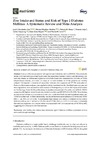Identificador persistente para citar o vincular este elemento:
https://accedacris.ulpgc.es/jspui/handle/10553/63296
| Campo DC | Valor | idioma |
|---|---|---|
| dc.contributor.author | Fernandez-Cao, Jose C. | en_US |
| dc.contributor.author | Warthon-Medina, Marisol | en_US |
| dc.contributor.author | Moran, Victoria H. | en_US |
| dc.contributor.author | Arija, Victoria | en_US |
| dc.contributor.author | Doepking, Carlos | en_US |
| dc.contributor.author | Serra Majem, Luis | en_US |
| dc.contributor.author | Lowe, Nicola M. | en_US |
| dc.date.accessioned | 2020-01-21T13:09:39Z | - |
| dc.date.available | 2020-01-21T13:09:39Z | - |
| dc.date.issued | 2019 | en_US |
| dc.identifier.issn | 2072-6643 | en_US |
| dc.identifier.other | WoS | - |
| dc.identifier.uri | https://accedacris.ulpgc.es/handle/10553/63296 | - |
| dc.description.abstract | Zinc could have a protective role against type 2 diabetes mellitus (T2DM). This systematic review and meta-analysis aimed to evaluate the association between dietary, supplementary, and total zinc intake, as well as serum/plasma and whole blood zinc concentration, and risk of T2DM. Observational studies, conducted on cases of incident diabetes or T2DM patients and healthy subjects that reported a measure of association between zinc exposure and T2DM, were selected. Random effects meta-analyses were applied to obtain combined results. Stratified meta-analyses and meta-regressions were executed to assess sources of heterogeneity, as well as the impact of covariates on the findings. From 12,136 publications, 16 studies were selected. The odds ratio (OR) for T2DM comparing the highest versus lowest zinc intake from diet was 0.87 (95% CI: 0.78-0.98). Nevertheless, no association between supplementary or total zinc intake from both diet and supplementation, and T2DM was observed. A direct relationship was found between serum/plasma zinc levels and T2DM (OR = 1.64, 95% CI: 1.25-2.14). A moderately high dietary zinc intake, in relation to the Dietary Reference Intake, could reduce by 13% the risk of T2DM, and up to 41% in rural areas. Conversely, elevated serum/plasma zinc concentration was associated with an increased risk of T2DM by 64%, suggesting disturbances in zinc homeostasis. | en_US |
| dc.language | eng | en_US |
| dc.relation.ispartof | Nutrients | en_US |
| dc.source | Nutrients [ISSN 2072-6643], v. 11 (5) | en_US |
| dc.subject | 32 Ciencias médicas | en_US |
| dc.subject.other | Serum Trace-Elements | en_US |
| dc.subject.other | Metabolic Syndrome | en_US |
| dc.subject.other | Postmenopausal Women | en_US |
| dc.subject.other | Regional Burden | en_US |
| dc.subject.other | Meta-Regression | en_US |
| dc.subject.other | Chinese Adults | en_US |
| dc.subject.other | Disease | en_US |
| dc.subject.other | Heterogeneity | en_US |
| dc.subject.other | Associations | en_US |
| dc.subject.other | Glucose | en_US |
| dc.title | Zinc Intake and Status and Risk of Type 2 Diabetes Mellitus: A Systematic Review and Meta-Analysis | en_US |
| dc.type | info:eu-repo/semantics/review | en_US |
| dc.type | Article | en_US |
| dc.identifier.doi | 10.3390/nu11051027 | |
| dc.identifier.scopus | 85065895364 | |
| dc.identifier.isi | 000471021600087 | - |
| dc.contributor.authorscopusid | 55931839600 | |
| dc.contributor.authorscopusid | 57208822722 | |
| dc.contributor.authorscopusid | 7004096416 | |
| dc.contributor.authorscopusid | 6602777492 | |
| dc.contributor.authorscopusid | 55791730300 | |
| dc.contributor.authorscopusid | 35596972100 | |
| dc.contributor.authorscopusid | 7102428454 | |
| dc.identifier.issue | 5 | - |
| dc.relation.volume | 11 | - |
| dc.investigacion | Ciencias de la Salud | en_US |
| dc.type2 | Reseña | en_US |
| dc.contributor.daisngid | 25435465 | |
| dc.contributor.daisngid | 2592699 | |
| dc.contributor.daisngid | 798222 | |
| dc.contributor.daisngid | 283101 | |
| dc.contributor.daisngid | 11405922 | |
| dc.contributor.daisngid | 31465462 | |
| dc.contributor.daisngid | 451876 | |
| dc.utils.revision | Sí | en_US |
| dc.contributor.wosstandard | WOS:Fernandez-Cao, JC | |
| dc.contributor.wosstandard | WOS:Warthon-Medina, M | |
| dc.contributor.wosstandard | WOS:Moran, VH | |
| dc.contributor.wosstandard | WOS:Arija, V | |
| dc.contributor.wosstandard | WOS:Doepking, C | |
| dc.contributor.wosstandard | WOS:Serra-Majem, L | |
| dc.contributor.wosstandard | WOS:Lowe, NM | |
| dc.date.coverdate | Mayo 2019 | |
| dc.identifier.ulpgc | Sí | es |
| dc.description.sjr | 1,329 | |
| dc.description.jcr | 4,546 | |
| dc.description.sjrq | Q1 | |
| dc.description.jcrq | Q1 | |
| dc.description.scie | SCIE | |
| item.grantfulltext | open | - |
| item.fulltext | Con texto completo | - |
| crisitem.author.dept | GIR IUIBS: Nutrición | - |
| crisitem.author.dept | IU de Investigaciones Biomédicas y Sanitarias | - |
| crisitem.author.dept | Departamento de Ciencias Clínicas | - |
| crisitem.author.orcid | 0000-0002-9658-9061 | - |
| crisitem.author.parentorg | IU de Investigaciones Biomédicas y Sanitarias | - |
| crisitem.author.fullName | Serra Majem, Luis | - |
| Colección: | Reseña | |
Los elementos en ULPGC accedaCRIS están protegidos por derechos de autor con todos los derechos reservados, a menos que se indique lo contrario.
